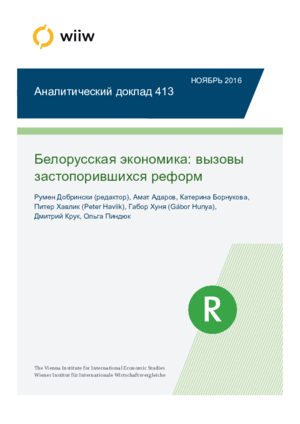The Belarus Economy: The Challenges of Stalled Reforms, Russian Version: Белорусская экономика: вызовы застопорившихся реформ
Amat Adarov, Kateryna Bornukova, Rumen Dobrinsky, Peter Havlik, Gabor Hunya, Dzmitry Kruk and Olga Pindyuk
wiiw Research Report No. 413, November 2016
172 pages including 20 Tables, 61 Figures and 6 Boxes
Twenty-five years after the dissolution of the Soviet Union, Belarus stands out as a special case in transition blending, on the one hand, signs of relative prosperity, socially oriented policies and sprouts of entrepreneurships and, on the other hand, remnants of the communist past. The core of the Belarusian economic model throughout most of this period was a combination of external rents and soft budget constraints on the state-owned part of the economy backed by a strong system of administrative control. In periods of favourable external conditions this mix provided for relatively high rates of economic growth and allowed the authorities to maintain a ‘social contract’ with the population targeting close to full employment. But this model also led to the persistent accumulation of a quasi-fiscal deficit which time and again came to the surface, and its subsequent monetisation provoked macroeconomic and currency turmoil. At present, Belarus’ economic model has run up against its limits and policy changes seem inevitable.
This is the English Version of wiiw Research Report No. 413: The Belarus Economy: The Challenges of Stalled Reforms
Keywords: Беларусь, экономические преобразования, макроэкономическая политика, мягкие бюджетные ограничения, валютный кризис
JEL classification: E65, O52, P30, P52
Countries covered: Belarus
Research Areas: Macroeconomic Analysis and Policy
Press Releases
Related Presentations
Related News
- Just released: wiiw Handbook of Statistics 2016
- The Belarus Economy: The Challenges of Stalled Reforms
